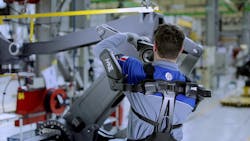This article originally appeared on May 3, 2019.
Just about every industry show or conference these days has some level of debate about whether robots and other forms of automation are taking people’s jobs. There are several different arguments for automation, but a key one centers around the inability of a manufacturer to provide any jobs if it can’t stay in business.
At its booth during the recent Automate show in Chicago, Comau had a somewhat different perspective, emphasizing how central humans are to the technologies it’s been rolling out—and how much those technologies are there specifically to help the human workers on the plant floor. They call it Humanufacturing, where people play the leading role.
“We don’t believe in plants without people,” said Pietro Ottavis, chief operating officer of Comau’s robotics and automation products business unit. Machines can be there for the heavy lifting and the repetitive tasks, he added, but the people will always need to intervene.
The virtual and wearable technologies Comau was showing at Automate were designed to increase productivity and quality within the evolving smart factory. They included the North American launch of its wearable exoskeleton, plus the global launch of both a digital assistant for manual operations and an interactive Internet of Things (IoT) platform that combines digital and physical manufacturing environments.
Exoskeleton
Ottavis is also president of IUVO, a spin-off company of the BioRobotics Institute at the Sant’Anna School of Advanced Studies in Italy. The company, operated as a joint venture between Comau and orthopedics provider Össur, focuses specifically on wearable exoskeletons. This was a big draw at Comau’s Automate booth.
Comau introduced its Mate exoskeleton to the European market last summer at Automatica in Munich. The Automate show in Chicago was its North American debut. Like other attendees, I got to try out the exoskeleton at the show, using it to help hold my arms up as I screwed bolts onto the upper reaches of a pole. Though it would certainly take some getting used to, it was clear how much the exoskeleton would provide movement assistance in jobs requiring repetitive tasks throughout the day.
It uses an advanced passive structure and delivers lightweight, breathable and effective postural support without the need for batteries, motors or other devices. It replicates any movement of the shoulder while adhering to the body. What struck me most while wearing the Mate was actually my ability to put my arms back down when I wanted to. I thought they’d be stuck in an awkward reaching position, but it actually gives the worker freedom of movement.
Mate has been in production since the beginning of the year, according to Ottavis. An obvious application is for people working under the body of a car, he said, but the exoskeleton has been tried in several non-automotive industrial applications, with encouraging results in aerospace, food and beverage, and logistics spaces. “It was developed with operators in plants,” he said, commenting on the variety of applications Comau studied. “When you find the right application, the feedback is very good.”
IoT platform
Making its global debut was Comau’s in.Grid interactive IoT platform, which combines digital and physical worlds through sensorization, data analysis and real-time monitoring of equipment and systems. With it, operators can quickly verify production parameters at any stage of the manufacturing process, streamline maintenance operations and prevent problems before they occur.
The in.Grid platform facilitates the acquisition and exchange of data by interconnecting Comau and non-Comau manufacturing systems. This not only enables process/technology data monitoring and telemetry, but can provide companies with predictive maintenance and productivity tools. The data collection, processing and connectivity is done at the machine, line or plant level; the data analysis platform can be hosted at the plant itself, at an external data center or in a private cloud.
“In.Grid is essentially an open network that collects, stores and elaborates data in order to predict, adapt and eventually self-adjust to the dynamic conditions of manufacturing processes,” said Maurizio Cremonini, Comau’s head of marketing and digital initiatives platform. “As an Industry 4.0 facilitator, the platform also allows for the creation of a digital twin environment which enables operators to identify early warning signs, conduct predictive and preventive maintenance, make projections based on the digitized performance data, simulate corrective actions on the virtual environment, measure related results, transfer corrections or process modifications to the physical line.”
Digital assistant
Another interesting technology that Comau let booth visitors get their hands on at Automate was Vir.GIL (Virtual Guidance Interactive Learning). Also making its global debut, it’s a digital assistant for manual operations—using different shaped lights to guide the worker along the correct sequence, sensors to follow the worker, and integrated intelligence to track and certify the process. The operator can use speech and gestures to interact with the technology.
In the booth demonstration, Comau showed how lights help a worker know the proper procedure. But it also has the ability to disable a screwdriver, for example, if the steps aren’t being done in the right order. This learning goes both ways. The technology is not only used to help the worker understand what to do, it can also be used to teach Vir.GIL new work sequences. By putting it in machine-learning mode, an expert operator performs and confirms each position of an assembly process, telling Vir.GIL to memorize the hand positions and intervention points. Once Vir.GIL learns the sequence, the system can guide a non-experienced operator to achieve the same level of performance.
“Digitalization alone isn’t enough to drive the future of smart manufacturing because until now it has largely excluded the human aspect,” Cremonini said. “Vir.GIL will become a fundamental part of Comau’s Humanufacturing philosophy, which puts mankind at the center of Industry 4.0, by also bringing digital intelligence to manual manufacturing processes.”
About the Author
Aaron Hand
Editor-in-Chief, ProFood World

Leaders relevant to this article:
